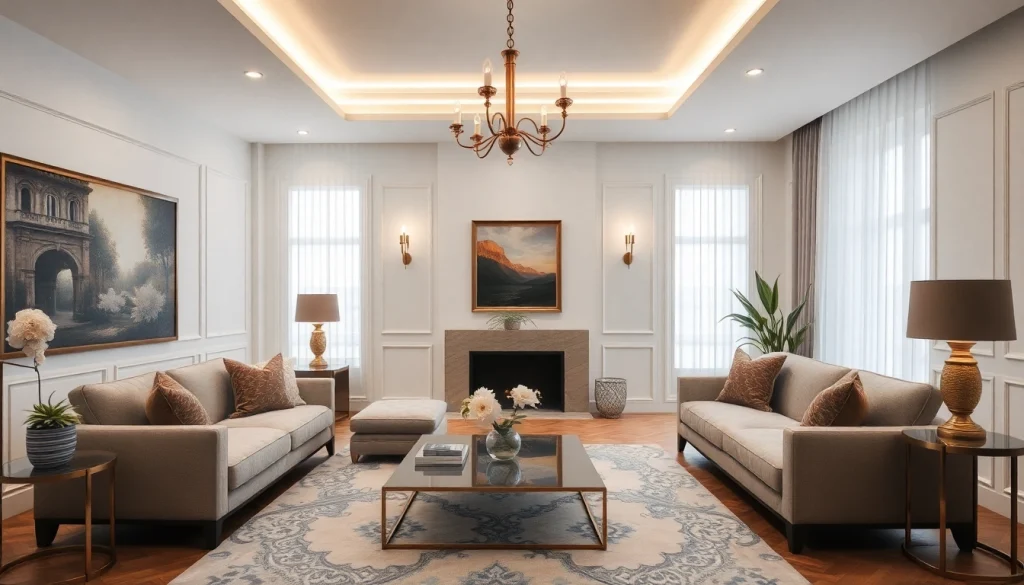
Understanding Luxury: More than Just Materialism
Defining Luxury in Today’s Society
Luxury is a concept many aspire to, often misconceived merely as a synonym for wealth and affluence. A more nuanced understanding reveals that luxury transcends materialism; it encompasses an experience, a state of comfort, and exclusivity. In contemporary society, luxury has morphed into a broader representation of a lifestyle characterized by elegance, sophistication, and individuality. The essence of luxury is not solely found in the price tag but also in the feelings it engenders—be it comfort, status, or the joy derived from beautiful, well-crafted items. As such, luxury often reflects personal values and the unique circumstances of individuals, making its definition subjective and multifaceted.
The Psychology Behind Luxury Purchases
Purchasing luxury goods is deeply intertwined with human psychology. The act of acquiring high-end items often fulfills more than just a functional need; it satisfies emotional and social aspirations. Numerous studies indicate that luxury goods are associated with self-esteem and personal identity, where consumers seek to align their purchases with their self-concept. For example, owning a luxury vehicle might symbolize success, while haute couture fashion could reflect sophistication and exclusivity.
Moreover, the notion of exclusivity plays a significant role in the luxury market. Many luxury brands implement scarcity tactics, making their products harder to obtain. This concept ties back to psychological phenomena such as the “bandwagon effect,” where individuals are inclined to purchase luxury items due to their social desirability and perceived status.
Luxury vs. Necessity: Finding Balance
The line between luxury and necessity has blurred over time. In today’s fast-paced world, where convenience is sought after, luxury items often fill the gaps left by essential products. This convergence raises critical questions: Are luxury goods necessities in contemporary society, or do they merely represent indulgence?
To delve deeply into this, one must examine the value proposition of luxury goods. High-quality, artisanal products offer durability and timelessness, potentially making them wise investments in a cluttered marketplace of fast fashion and disposable items. Individuals must strive for balance, discerning between what brings genuine joy and benefit versus what may simply serve superficial desires.
Luxury Goods: Characteristics and Examples
High-End Fashion: Setting Trends in Luxury
High-end fashion epitomizes the luxury market. It is defined by craftsmanship, exclusivity, and the ability to set trends rather than follow them. Brands like Chanel, Louis Vuitton, and Gucci not only produce aesthetically pleasing garments but also infuse art and cultural significance into their creations. Their marketing strategies often revolve around storytelling, where each piece narrates a history that enhances its value.
High-end fashion showcases limited collections that create urgency and desirability among consumers. Examples include runway pieces that may only see a few units produced, elevating their status as collectible items over time. This exclusivity often leads to a culture of prestige, where those who can afford such garments simultaneously gain social acknowledgment.
Luxury Automobiles: Engineering the Extraordinary
The automotive industry is another realm where luxury thrives. Brands like Rolls Royce, Bentley, and Ferrari represent the zenith of automotive craftsmanship and engineering. Luxury automobiles are not merely vehicles; they symbolize a lifestyle marked by precision, luxury materials, and advanced technology. Each car is a melding of art and science, designed to provide exceptional performance while catering to aesthetic desires.
The experience of owning such a vehicle extends beyond fulfillment of transportation needs. The brand’s legacy, customer service, and community often add layers of value. For instance, exclusive automotive events offer luxury car enthusiasts networking opportunities, furthering the allure of ownership.
Gourmet Experiences: Dining as a Form of Luxury
Luxury dining experiences elevate the act of eating into an art form, characterized by ambience, service quality, and culinary innovation. Michelin-starred restaurants such as The Fat Duck in the UK or Noma in Denmark offer more than just meals; they provide journeys through taste and creativity. High-end dining is about the overall experience, including the venue’s aesthetic and service quality, which transforms a simple meal into a memorable occasion.
Additionally, the surge in interest for gourmet experiences exemplifies the intersection of food and luxury—a shift towards mindful eating wherein every detail from the sourcing of ingredients to plating aesthetics is meticulously curated. This focus on quality signifies a broader trend where consumers are willing to invest in experiences that nourish the soul.
The Economic Impact of Luxury Markets
Understanding Luxury Goods Demand
The demand for luxury goods has been steadily increasing, a phenomenon fueled by rising disposable incomes, especially in emerging markets. Economists classify luxury goods as those which see an increase in demand as consumer income rises—an exceptional characteristic that differentiates them from basic commodities.
As globalization continues its march, brands that were once confined to specific locales are now accessible worldwide, leading to an expanded consumer base. However, in increasingly saturated markets, luxury brands are challenged to maintain exclusivity and desirability. For instance, while demand may rise in Asia, brands must navigate local cultural nuances and consumer behavior to successfully penetrate these markets.
The Global Luxury Market Growth Trends
Luxury markets are in a continual state of evolution, heavily influenced by demographic shifts, consumer behaviors, and technological advancements. The global luxury market, valued at approximately $1.5 trillion in 2020, is projected to exceed $2 trillion within the next decade, highlighting significant growth potential. Notably, younger consumers—Gen Z and millennials—are reshaping the luxury landscape, prioritizing ethical consumption and experiential values over mere possession.
Companies respond by shifting marketing strategies to emphasize not just the product but the story behind it—sustainability efforts, craftsmanship, and community impact play key roles in modern branding. Successful brands provide transparency, building loyalty through strong relationships with consumers.
Luxury Brands: Building and Sustaining Value
Luxury brands thrive on their ability to create and sustain value over time. Unlike mass-market products, luxury items derive their worth from tradition, authenticity, and the irreplaceable quality of their craftsmanship. Maintaining brand integrity involves a continuous effort to resonate with consumer values, adapting without losing what makes the brand unique.
A case study of successful brand longevity is that of Hermès, renowned for its impeccable craftsmanship and exclusivity. The strategy of preserving limited product availability while simultaneously expanding its offerings has allowed it to flourish for over a century. Such practices include maintaining handcrafted processes that reinforce brand authenticity and values.
Sustainability in the Luxury Sector
Ethical Luxury: Redefining Expectations
The concept of ethical luxury has emerged as a response to growing consumer awareness about sustainability and social responsibility. Consumers increasingly demand products that reflect their values, prompting luxury brands to innovate responsibly. Ethical luxury encompasses sustainable sourcing, eco-friendly materials, and fair labor practices integrated throughout the supply chain.
Brands like Stella McCartney and Gucci have taken significant strides in this direction, implementing sustainable practices that align with higher ethical standards. Stella McCartney, for instance, has long advocated for vegetarian fashion, using sustainable materials and advocating against animal cruelty, solidifying her brand as a pioneer in combining fashion with ethics.
Eco-Friendly Luxury Brands to Watch
Increasingly, consumers seek luxury brands that prioritize environmental sustainability. Companies adopting eco-friendly strategies are gaining attention and market share. Some noteworthy brands include:
- Reformation: Known for its commitment to sustainable practices and transparency in manufacturing.
- Allbirds: A shoe brand notable for using renewable materials and environmentally conscious production.
- Patagonia: While not traditionally classified solely as ‘luxury,’ its high-quality, sustainable outdoor gear embodies the essence of ethical consumption.
These brands redefine luxury by showcasing that one can indulge in quality without compromising environmental standards, aligning modern consumer expectations with their corporate missions.
The Future of Sustainable Luxury Goods
As the demand for sustainable products continues to grow, the future of luxury goods inevitably intertwines with sustainability. Innovations in materials science, like lab-grown textiles and biodegradable composites, are paving the way for a more sustainable luxury industry. Imagine purchasing a designer dress made from entirely biodegradable silk that leaves no harmful footprint—such possibilities are not far-fetched but rather a glimpse of what lies ahead.
Luxury brands will increasingly be expected to demonstrate their commitment to sustainability visibly. This will involve integrating sustainable practices from the inception of the product through to its end of life, with brands providing education and incentives for consumers on how to extend the lifecycle of luxury goods.
Experiencing Luxury: How to Incorporate It into Your Life
Creating a Luxury Atmosphere at Home
Incorporating luxury into daily life does not always necessitate exorbitant expenditure. A luxury atmosphere at home can be cultivated through thoughtful design, carefully curated decor, and high-quality elements that create comfort. Invest in fewer, high-quality pieces that promise durability and timeless appeal instead of filling spaces with transient items.
Elements such as soft, sumptuous fabrics, strategically placed artworks, and neutral palettes can create an inviting yet sophisticated ambiance. Adding personal touches such as artwork or books that resonate with one’s interests enhances the luxurious feel, turning a house into a personalized home.
Luxury Travel: Exquisite Destinations for the Discerning Traveler
When it comes to luxury travel, the journey is as paramount as the destination. High-end travel experiences offer more than just comfortable accommodations; they provide immersive cultural interactions, personalized service, and exclusive access to local gems often overlooked by the ordinary traveler. Consider destinations such as Bali for an exquisite resort experience or the Amalfi Coast for breathtaking views paired with culinary delights.
Luxury travelers now prioritize unique experiences that enrich their lives, often seeking wellness retreats, culinary tours, and immersive cultural experiences over traditional sightseeing. Experts suggest leveraging luxury travel agencies that tailor itineraries to individual preferences as a way to optimize the journey.
Investing in Luxury: Making Smart Purchase Decisions
Investing in luxury items requires discernment and foresight. High-end brands often appreciate over time, transforming purchases into potential financial assets. However, to achieve this, one must do thorough research on market trends and brand history.
To make informed decisions, consider factors such as brand heritage, quality, the popularity of particular pieces, and potential resale value. Items like vintage handbags from brands like Chanel or limited-edition luxury watches typically hold or increase their value with time. Utilizing platforms that specialize in luxury item sales can also provide a marketplace for eventual resale, maximizing the return on investment.





